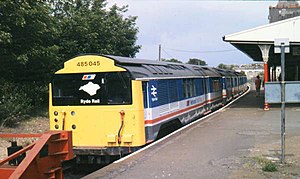British Rail Class 485
| British Rail Class 485 British Rail Class 486 |
|
|---|---|

Class 485 no. 485045 at Shanklin railway station, current terminus of the Island Line.
|
|
| In service | 1923 on London Underground 1967 - 1992 on Island Line |
| Manufacturer | Metro Cammell, Union Construction Company, Cammell Laird |
| Family name | Tube |
| Formation |
|
| Diagram |
|
| Capacity |
|
| Operator(s) | Network SouthEast |
| Specifications | |
| Maximum speed | 45 mph (72 km/h) |
| Weight |
|
| Electric system(s) | 630 V DC 3rd rail |
| Track gauge | 1,435 mm (4 ft 8 1⁄2 in) standard gauge |
The British Rail Class 485 (or 4Vec, later 5Vec) and British Rail Class 486 (or 3Tis, later 2Tis) electrical multiple units were originally built for the London Electric Railway from 1923-31 as their . They were purchased by British Rail in 1967 and transported to the Isle of Wight to work 'mainline' services on the newly electrified Ryde to Shanklin line, where they worked for an additional quarter century. At the time of their purchase the units had already worked for over forty years on the London Underground, but their introduction allowed the last steam locomotives on the line to be withdrawn.
Six four-car sets and six three-car sets were refurbished by BR's Stewarts Lane depot in 1966-67. The four-car sets were initially classified Class 452 and numbered 041-046, later reclassified Class 485 and numbered 485041-046. Each unit was formed of a driving motor, two intermediate trailers, and a second driving motor. Thus, the formation was DMBSO+TSO+TSO+DMBSO. Some of the intermediate trailers were former driving trailers, with the cabs locked out of use.
The three-car sets were classified Class 451 and numbered 031-036, later reclassified Class 486 and numbered 486031-036. A spare driving motor car was also refurbished, given the unit number 486037. Each of these units were formed of a driving motor, an intermediate trailer, and a driving trailer. Thus, the formation was DMBSO+TSO+DTSO.
When introduced, the units carried all-over BR blue livery. This progressed to standard blue/grey livery in the 1970s, and finally some units received Network SouthEast's blue livery with red and white stripes, following its introduction in 1986.
Electric services on the Isle of Wight commenced on 20 March 1967. In service, the 4Vec units often worked alone, but sometimes in combination with a 3Tis unit, such that a train was formed of seven coaches known as a 7 Vectis. ("Vectis" was the Roman name for the Isle of Wight.)
...
Wikipedia
